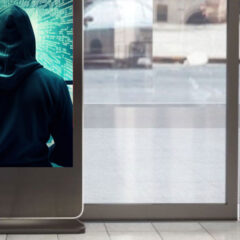Show and Tell: Video Walls Revolutionize the Customer Experience

They say seeing is believing, and research suggests there’s a great deal of truth in that old adage. Studies find that roughly two-thirds of people are visual learners who need to see information in order to retain it.
The capacity to enhance understanding and influence decisions makes video imagery a critical component of the customer experience these days. And many organizations are finding that bigger is better. That’s why we’re seeing a sharp increase in the use of video walls. Technically, a video wall is any installation larger than a 105”-class screen. However, most video walls feature multiple high-definition displays arranged as a single screen to capture the attention of large audiences.
Video walls are being used in shopping malls, airports, conference centers and other public spaces to display information, advertising or video content. According to a recent market study by Research and Markets, the global market for video wall technology is growing by 21.4 percent annually and will reach a total value of $67 billion by 2027.
Large-scale video walls have been around since the 1980s, but refinements have contributed to a recent surge in business use cases. The first walls that used old, cathode-ray tube television sets were big, bulky and difficult to configure. The development of flat-panel liquid crystal displays (LCDs) in the early 2000s sparked more mainstream usage, but the market has really taken off in recent years with the emergence of direct view LED (DvLED) screens.
As we noted in a recent post [X], DvLED screens are lighter, more durable and generate less heat than LCD screens while also producing brighter and more vivid images. More important, when DvLED displays are tiled together, they create seamless, edge-to-edge images without the visible bezels that create distracting black borders around individual LCD screens. Those characteristics allow DvLED screens to be customized for a variety of formats and sizes — including very large formats of 100 feet or more.
The size and image quality of the newer screens make video walls increasingly popular for a wide range of applications. Common use cases for video walls include:
Retail. Shopping malls and retail stores use video walls for advertising, promotion and wayfinding. When used to display product information, special deals and promotions, they help create an engaging and immersive shopping experience.
Hospitality and entertainment. Hotels, casinos and theme parks use video walls for wayfinding, advertising, and entertainment purposes. Giant-format walls have practically become table stakes at professional and college sports stadiums and arenas for displaying live feeds, instant replays and statistics.
Corporate. Video walls are often used in corporate settings such as conference rooms, lobbies, boardrooms and tradeshows for presentations and video conferencing. Many companies also use them to display company announcements, key performance dashboards and other types of company communications.
Transportation. Video walls are especially common in transportation hubs such as airports, train stations and bus terminals, where they are used for wayfinding and for displaying real-time information on arrivals, departures and delays.
While video walls offer a range of benefits for both customers and businesses, they can be tricky to set up. You first need to determine the size and layout of your wall before mounting all your screens with brackets or stands. You’ll also need to install and configure a video controller to manage content distribution as well as software for controlling the layout and video settings.
The digital signage experts at SageNet have extensive experience in designing, implementing and managing all types of signage solutions, including large-format video walls. Contact us to set up a complimentary meeting to discuss your signage needs.
More Insights
-
 Digital Experiences, SageVIEW Approach
Digital Experiences, SageVIEW ApproachHow Digital Signage Boosts Workforce Productivity
-
 Digital Experiences
Digital ExperiencesHow Digital Signage Can Play a Role in Reducing Workplace Stress
-
 Digital Experiences
Digital Experiences7 Steps for Upgrading and Enhancing a Digital Signage Network
-
 Digital Experiences
Digital ExperiencesWhy You Should Make Digital Signage Security a High Priority
